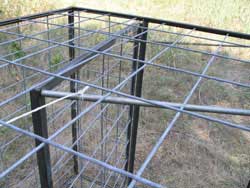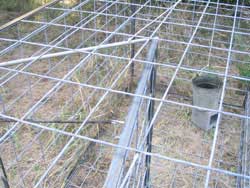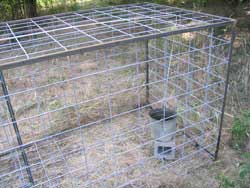In This Section
How to Bait and Use Your Hog Trap
Early Baiting For Success
What you'll need to use your trap:
- Bucket.
- Cinder block.
- Deer corn.
- Prop for the door, such wooden dowel.
- Clothesline rope.
Pre-Bait For Success
 |
Fig. 1 |
 |
Fig. 2 |
 |
Fig. 3 |
Depending on the hog infestation, you may not need to perform any pre-baiting of the area to achieve success.
But — if you're dealing with skittish hogs — these steps will pay off.
Hogs have an excellent sense of smell, and after building it, your scent covers the trap. Also they may need time to get used to the new structure.
So, place the trap in the area that you've found hog sign. For the first week, remove the spring and tie the door open. Spread corn around the area in place plenty inside the trap.
The greedy hogs will pack themselves into the trap — this will get them used to entering the trap by having to push through the crowd. To pre-bait on a continued basis, you could even set a deer feeder up at the trap.
After the wiley pig has become accostumed to feeding in and around the trap you're ready to start trapping.
If you set the trap without pre-baiting and don't have success the first time, don't become discouraged, just try again.
Some people sour their corn first. You can do this by filling a bucket of corn with water and letting it sit out for several days. You'll know when it's sour.
Swing Door Setting
If you're using the swing-door style, set the animal trap by first filling your clean bucket with the corn.
Place the bucket on top of the block in the rear of the trap. Tie one end of the rope to the bucket and pass the rope through the top of the trap.
Run the rope up to the front. Open the trap door and place the prop between the jamb and the edge of the door. The prop should be long enough to open the door wide.
Attach the rope to the prop so there is little to no slack. We've found that using a dowel large enough to drill a hole in allows one to tie the rope to the prop securely.
If everything goes right, the hog will knock the bucket from the block, which will pull the rope tight, pull the prop from the door, and the door will swing shut.
When You Trap One
Check the trap each morning for your catch. Be careful approaching the trap as the hogs may be very angry. If you shoot the hogs in the trap, use extreme caution for ricochets.
If They Got Away
If there's no pigs and no corn, then you've been had! Tighten up that spring so they can't escape.
If your corn is gone, but the trap didn't set, then you can put the bucket on top of a taller block inside the trap giving the bucket farther to fall and should trip the trigger easier.
If your corn is there, and the trap is tripped, then perhaps the hogs are too wide to fit in the trap without knocking out the prop. Use a larger prop. It could also be that a deer is trying to enter.
